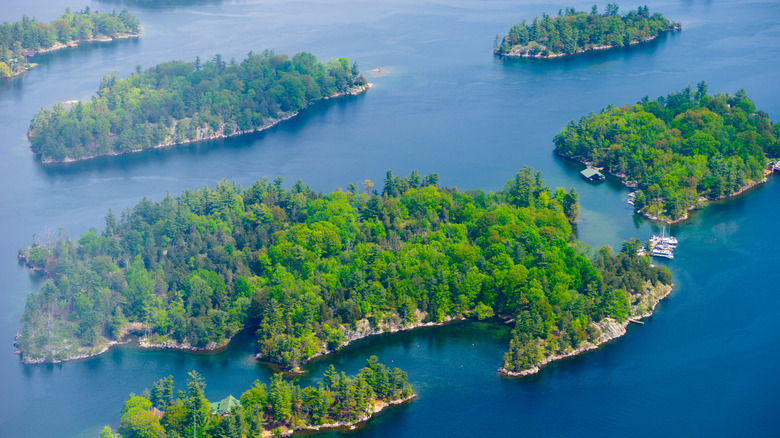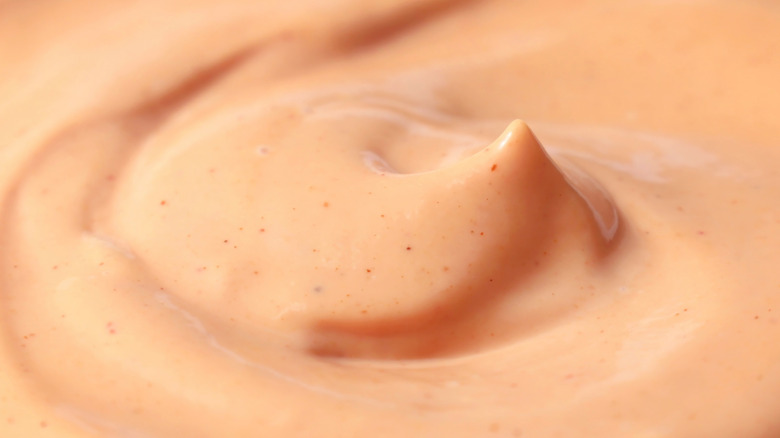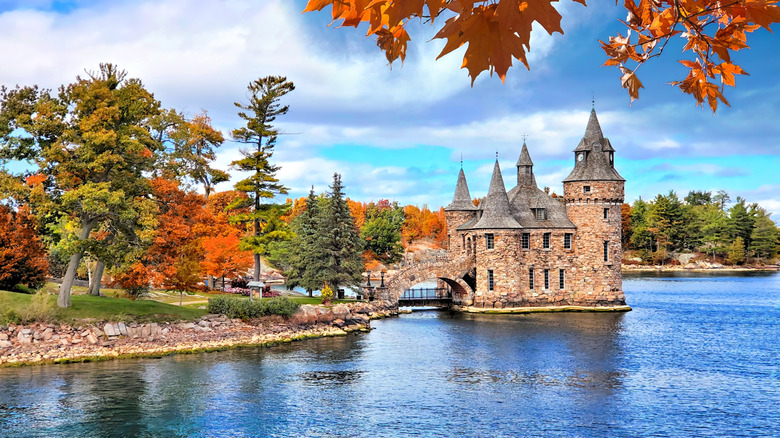Thousand Islands Is A Real East Coast Destination That Inspired The Tasty Salad Dressing
Love it or hate it, you've likely heard of Thousand Islands (also called just Thousand Island) salad dressing, a mix of mayonnaise and ketchup that's often served on salads and in burgers or sandwiches. Despite the ubiquitous nature of this dressing, very few know its origin story. Thousand Islands (the dressing) was first created in Thousand Islands, the place. A gorgeous chain of islands scattered on the St. Lawrence River straddling the United States-Canadian border and home to Canada's Thousand Islands National Park, the islands are part celebrity retreat, part protected wilderness, and part adventure destination, yet these picturesque East Coast islands still manage to fly under the radar.
The islands — which actually consist of about 1,864 separate islands — are unique, and not just as the home of the eponymous dressing. As the islands are dotted along the border, the eastern islands are considered part of New York, while the western islands are part of Canada (Ontario, specifically). Each inhabited island also has its own history and charm, not to mention legends. Here, you'll find stories of smuggling and shipwrecks, hidden treasure and visiting presidents, Gilded Age balls, and awe-inspiring castles. This includes the stunning Boldt Castle, one of the most amazing castles you can visit in the U.S. And, of course, several of these varying islands have their own idea of just how the famous dressing came about.
The story of Thousand Islands (the dressing)
The namesake dressing of one of the most beautiful places in Canada seems more well-known than the Thousand Islands themselves, and like all good origin stories, the history of Thousand Islands (the dressing) is somewhat controversial. One theory credits a fisherman, George LaLonde Jr., and his wife, Sophia. As tourism in the Thousand Islands boomed in the 1870s, many fishermen — including George — turned toward guiding, and part of these fishing excursions included a traditional "Shore Dinner" cooked by the guide. George's dinners became famous thanks to his wife's sauce, and "Sophia's Sauce" caught the attention of Hollywood star May Irwin, who asked for the recipe. A nearby hotel, where Irwin often stayed, was also given the recipe. When the hotel was sold in the 1970s, the new owner discovered a handwritten card featuring "Sophia's Sauce" in a safe. The original recipe is still highly guarded — the only confirmed ingredients are mayonnaise and pickle relish.
Another story says that George Boldt — who built the famous Boldt Castle — was sailing around the islands when his chef, Oscar Tschirky, created a version of Thousand Islands dressing. Tschirky, who'd forgotten a salad dressing, invented one from mayonnaise, ketchup, relish, and a hardboiled egg. Boldt reportedly insisted it be served at his hotel, the Waldorf Astoria in New York. It's also said that May Irwin is the one who actually introduced the Boldts to the recipe, while yet another version has Tschirky purchasing the recipe from a formerly royal chef, Angebault, who also worked for Boldt.
Since many of these stories have been passed down orally or with little documentation, we'll likely never know the true story. Whatever the truth is, there's one thing that's not disputed: Thousand Islands dressing started in the Thousand Islands (somewhere)!
The story of Thousand Islands (the place)
The islands have a long and rich history. Before the arrival of colonizers, many Indigenous tribes — including those from the Iroquois and Algonquin nations — lived on the islands for generations. To the Iroquois, the islands were known as 'Manitonna, the "Garden of the Great Spirit." Significant archaeological evidence of these people has been found on the islands, and the First Peoples Circle of the Thousand Islands aims to keep the customs and cultures alive.
During the War of 1812, the region saw many clashes between Canada (under British control) and the United States. Several battle sites and military fortifications can be visited today as historical points of interest. The islands were a hotspot during the Gilded Age when the wealthy and the famous flocked there. The region, only about 350 miles from New York City, was an ideal destination when travel overseas was more difficult and land travel was not nearly as efficient. Many islands were privately owned during this period, and gorgeous castles from this era still stand. Due to its location on the border, smuggling was an honored tradition on the St. Lawrence River, Thousand Islands included. During Prohibition, the islands hosted many bootleggers, known locally as 'River Rats.' Some towns, like Clayton, were home to some of the best speakeasies in New York.
Today, the islands are scattered with heritage towns and historic sites. They also draw their fair share of adventurers, from scuba divers exploring underwater shipwrecks to kayakers cruising between the islands or cross-country skiers. Fishing remains a popular pastime, as well as an occupation for many of the locals. And although you'll (likely) see fewer millionaires, the islands buzz with activity, hosting festivals every season.


